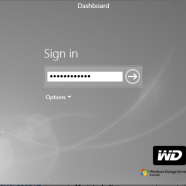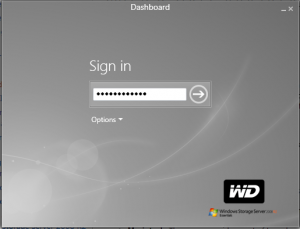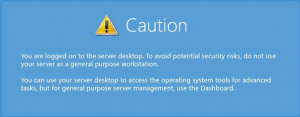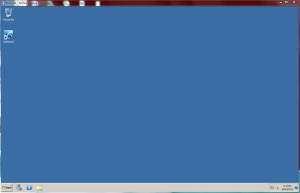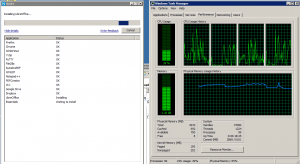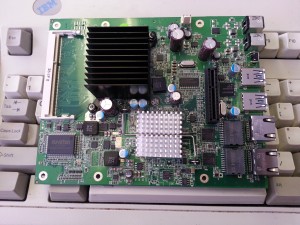WD Sentinel DX4000 Part 2
Pushing beyond the design specs
I’ve got a Western Digital Sentinel DX4000 in the lab to play with. There were a few minor hiccups during install, but overall I’m quite impressed with the unit. What captures the imagination, however, isn’t the unit as shipped, but the unit as it can be configured.
When you set up the system you are asked to interact with it through a fairly primitive installable client. Most users will never even know they can RDP into the thing. What’s amusing is that the installable client is in fact an RDP client with no “chrome.” The Dashboard is nothing more than an application running on the NAS’ native Windows Storage Server 2008 R2 Essentials install that is presented to the end user over RDP.
The presentation is fairly seamless, it’s easy to miss the Remote Desktop Connection (RDC) client flashing up for a fraction of a second as the dashboard launches. But it’s RDP nonetheless, and you can simply fire up the traditional RDC client and log in with the administrator username and the password configured during initial setup.
Voila: one fully functional Windows Server 2008 R2 install. Now for a number of reasons Microsoft does not under any circumstances want you in here mucking about. The most obvious being that you could theoretically install applications or deploy services that it normally reserves for people who buy much more expensive SKUs. They even give you a cute little warning to that effect.
What’s behind port 3389?
I naturally disregarded this entirely and began mucking about. A few things leap out at me. The first is that Western Digital has done some customizing. There’s a Haali media splitter in here and codecs from Xiph.org. I approve.
They’ve also added some teaming software to the NICs – good idea – and a whole pile of WD software to do everything from run the LCD and SATA enclosure to provide AFP and Bonjour for the Apple users. There’s a Starwind iSCSI target (very nice) and the standard suite of driver software.
Except for the video card, that is; they didn’t install the driver for that. It makes sense, I suppose; there is no video output on the motherboard they are using and the Intel drivers do take up some RAM and CPU cycles. Still, I’m an obsessive nerd, so it was the first thing I fixed.
I must say that I approve of the customization of the OS. Someone went through this thing and set up scheduled tasks for pretty much every relevant maintenance task that you could imagine. If you were designing a Windows Server to install somewhere and take care of itself, this would be how you went about it.
Breaking the rules
Of course, that’s all about what’s actually installed on this thing. What I’m interested in is what can be installed on this thing. The OS partition is 60GB with about 40GB free after all the Windows Updates are done. This is plenty of space to install my regular suite of software.
Firefox and Chrome so that I don’t have to use IE when fetching new software. WinDirStat so that I can tell what is eating my drive space. 7-Zip for compression, Putty, FileZilla and WinSCP for moving files around, Sumatra and PDFCreator for handling PDFs, VLC and Plex for media, Libre Office because why not and both Dropbox and Google Drive.
From a media standpoint this system makes a decent VLC server, but isn’t exactly spectacular. Under the right conditions it has just enough oomph to transcode a 720p stream. There’s no hope of squeezing 1080p out of this. Standard def does just fine and you can still do nifty things like use the iSCSI target to host a few moderate-duty VMs while it chugs away on an SD movie in the background.
The best bit so far is installing Dropbox and Google Drive then sharing out those folders. There’s all sorts of abuse to be had here. The boring way to use this is simply to use it as a versioning backup system for any network files you toss on there.
The fun version of this is to take your entire user profile a map it across the network into the shared Dropbox folder. Look ma; my profile’s backed up! If you configure Dropbox to actually sync *.tmp files then you can even have it sync drafts of things you are working on in Word should Word do something awkward like crash before you’ve saved the document with a name. (Dropbox versions things, remember?)
I do this mostly because every time a file changes my local desktop informs me that such-and-such a file syncronised. It’s like having a real-time feed of what files are changing and when. I’m sure I could make up a “useful for troubleshooting” excuse, but the truth is I did it mostly because I can.
If you are going to play this game – and get into installing third party applications onto the device like I have – then you might consider voiding your warranty by opening it up and swapping out the 2GB DIMM for a 4GB DIMM. The system is perfectly balanced to operate with 2GB as originally designed. Start mucking about with additional programs, however, and that extra 2GB goes a long way.
Conclusion
I actually quite like this little NAS. For all intents and purposes it’s a professionally-built version of the exact sort of file servers I build for own network and my SMB clients. The design was better resourced and thus it looks better and is more efficient than the stuff I build on my own. On the downside it comes with that ridiculous dashboard software, but you can simply RDP into the thing and only ever have to see it when setting up iSCSI.
In all, good gear. It does what it is designed to do and has more than enough headroom to do even more. It’s a solid business unit and power user’s dream.
- Information Overload? There’s an app for that. - January 12, 2017
- Year end thank yous - December 23, 2016
- Archival cloud storage can be an affordable backup layer - October 3, 2016
- On the importance of the user experience - August 13, 2016
- Beyond the traditional storage gateway - June 17, 2016
- Data residency made easy - June 15, 2016
- DevOps shouldn’t be a straitjacket - March 15, 2016
- Preparing for Office 2016 - November 7, 2015
- Supermicro, VSAN and EVO:Rail - February 4, 2015
- Make a #WebScaleWish - November 21, 2014

